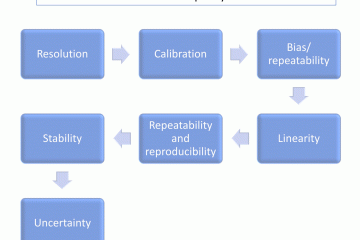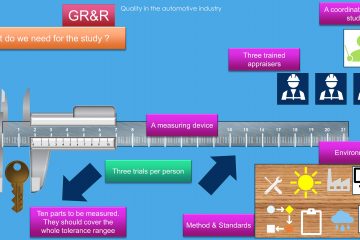What is an audit?
An audit is simply a comparison or a verification or can even be considered an assessment or a “measurement”. In the automotive industry audits are made to compare the “required condition” to the “real situation” or, in other words, the “shall” be (as per the standards) against the reality or “current condition”. This is normally done by using a reference standard as a base and verifying the fulfillement or degree of. For instance, the ISO9001 is the international standard which sets the requirements for the quality management systems and a system audit is the verification that the requirements (as described in the ISO9001 standard) are fulfilled.
Audits are considered as a “tool” to improve because if voids, deviations, nonconformities or performance problems are found, these will have to be solved/ improved and verified during the following audit. So, they are not only mandatory to the eyes of the customers, but also a great means to improve the quality management system.
When a QMS has been planned, implemented and properly used, we should have the means and/or be able to:
- Consistently deliver products which fulfill the legal/regulatory requirements as well as the customer requirements.
- Reach customer satisfaction and improve it whenever possible.
- Reduce variation of manufacturing processes and all kinds of waste.
- Have a good performance (effective and efficient processes).
- Attain good results and guarantee sustainability.
What do I audit then?
The main idea of any audit is to verify one of more of the following objectives:
- Compliance to the standard. For example, when we perform a system audit as per ISO9001 we will verify that the system of the auditees fulfills the requirements set in the standard. If the requirements are fulfilled, the system audited “complies”.
- Compliance to regulatory, legal or other compulsory requirements. An audit is an assessment, comparison or verification and therefore, we can “measure” whether the requirements are fulfilled and/or the degree in which they are fulfilled.
- Compliance to customer requirements. Customer requirements can be directed to the quality management system (called customer specific requirements -IATF16949-) to physical and functional product requirements, to service provision, etc. An audit, as mentioned above can be used to assess compliance or the degree of compliance.
- Performance. In the QMS standards the business processes should be measured in effectiveness and efficiency to know whether the objectives are met and how many/much resources were needed in the process.
Audit types
Audits can be performed in every discipline and business process, being perhaps the financial audits the most used for all industries and companies regardless of product, service or number of employees.
However, in the automotive industry and, related to the quality systems, we can classify the audit types in two basic groups:
- External audits: Those performed by third parties like certification bodies, customers or authorities.
- Internal audits: Performed by qualified personnel of the organization to assess compliance (or degree of).
Audits can also be classified depending on the scope as:
Both types can be directed to:
- System audits: Audits to verify or assess compliance (or degree of compliance) of one or all of the business processes of the organization as per the reference standard. These audits are called system audits because are based on international standards for “management systems” and can cover one or more of the following reference standards:
- ISO9001 for quality management systems.
- IATF16949 additional requirements on top of the ISO9001 for quality management systems of companies in the automotive industry
- ISO14001 for environmental management systems
- ISO45001 for health and work safety management systems
- ISO50001 for energy management systems
- etc.
- Process audits: Audits on manufacturing processes like plastic injection, soldering, metal stamping, etc. The objective is to comply to the requirements of IATF16949 or VDA 6.3. Depending on the reference standard to be used, processes should be audited in all working shifts and the overlap between them or consider the complete product life cycle.
- Product audits: performed on products at different station of the realization process as needed with the objective to confirm conformity to the product requirements (legal, customer, regulatory, functional, dimensional, etc.).
- Layer audits: Layer process audits or LPA are a “short” process audit which will be performed by different persons (in different hierarchicals levels – team leader, supervisor, shift leader, manager, director, etc.) in different frequencies and time slots to regularly assess how good the process is performed, work executed, disciplined maintained, data documented, etc.
- PFMEA / Control plan: audit to assess actuality and adequacy of the documents considering lessons learned, new knowledge gained through product/ process development, solving process (after claims, rejection, warranty) or improvement projects (scrap reduction, kaizen, six-sigma, etc.).
- CQI (Continuous Quality Improvement) standards which are process related like: coating, thermal treatment, etc.
How to perform an audit?
In general, the international standard ISO19011 sets the recommended guidelines on how to program, plan and execute an audit. It suggests how to gather information, assess compliance, define deviations and enounce non-conformities and finally how to close the process (to document and to write the report).
In the automotive industry there are competence-requirements for all auditors (system, process, product) and some may be additionally required for those who perform supplier audits. Basically any auditor needs to know the ISO9001, IATF16949, ISO19011, the company manufacturing processes and products, the core tools (APQP, FMEA, SPC, PPAP, MSA, control plan) and the applicable CSR (Customer specific requirements – additional requirements for the quality management system on top of the IATF16949 and set by the carmaker, i.e. Ford-).
The audits should be as objective as possible and be based on facts and evidence. Just like Deming used to say ” In God, I trust…. all others please bring data and evidence” 😉
Audit questionnaire? Forms? Methods?
In general, there are different support documents to perform audits like questionnaires, excel forms for recording and evaluating, etc. However, the auditor can decide to use or not a pre-defined questionnaire. Best practice is to use the process approach and follow the principles defined in the ISO19011.
I personally do not like to use questionnaires during the audit because:
- it takes a long time to prepare, interview and record data for all different process and auditees if I go line-by-line in a questionnaire
- i need to repeat most of questions to all related auditees to fully cover all points which makes the process too complex and long
- a rigid questionnaire limits my ability to apply the concept of “process approach” and evaluate the interactions with other processes.
The secret is a great planning and preparation before the audit and the use of the right techniques and recording aids during the audit. No question that questionnaires and forms are incredibly useful when summaring findings and enouncing the non-conformities when writing the audit report.
If you are interested, I will share some of methods and forms i use in the next posts.
Regards
Miguel



0 Comments